Recreating the Country blog |
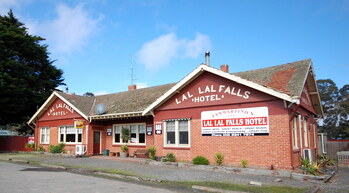 A very noteworthy feature of Lal Lal is its pub A very noteworthy feature of Lal Lal is its pub A sleepy town with something unique...other than the pub 22 kilometers south of Ballarat is the sleepy town of Lal Lal. Here if you explore a little you will uncover the usual small town amenities plus a very pleasing red brick pub and a beautiful but crumbling historic bluestone railway station. It’s also the home of a unique plantation that successfully marries biodiversity with forestry. Though many thought at the beginning that a happy long-term relationship was very doubtful 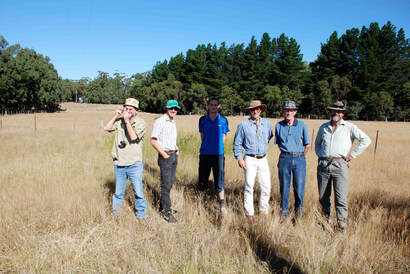 Imlal south. Ballarat Region Treegrowers first visit in 2010 Imlal south. Ballarat Region Treegrowers first visit in 2010 In the beginning Ten years ago a group of Foresters from the Ballarat Region Treegrowers scrambled over an old farm gate and walked onto an open field beside the road to the Lal Lal falls. The land was mostly a windblown swamp, but it was summer so the clay soil was hard, compacted and cracking. It had been offered to the foresters by the French mineral company Imerys, who mine kaolin nearby. The group was considering the land's potential for planting Australia’s first biorich demonstration plantation. 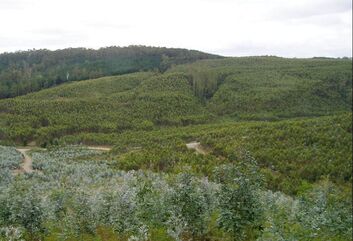 A typical forestry monoculture of Southern Bluegums, Eucalyptus bicostata, in the Otway Ranges A typical forestry monoculture of Southern Bluegums, Eucalyptus bicostata, in the Otway Ranges A worthy challenge They shared an interest in growing trees for profit and they also shared a desire to challenge one of the fundamental paradigms of forestry. The long held belief that commercial forestry should consist of monocultures of timber trees You have probably seen this type of forestry plantation. Usually vast plantings of a single species of pine or gum. They’re planted with the intention to harvest in 15 – 25 years. They’re a tree crop grown for the production of wood or pulp for paper. The nagging question for these foresters was ‘how can forestry plantations be made more biodiverse?’ This question loomed large in importance with the continued clearing of forests and woodlands in Australia, often to make way for planting forestry monocultures. Ecologists have known for decades that forestry monocultures don’t support the diversity of bird and insect life that is found in remnant forests nearby. 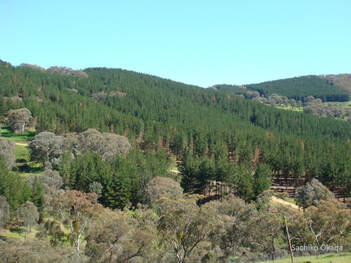 A Monterey Pine plantation, Pinus radiata incorporating remnants of a eucalypt woodland A Monterey Pine plantation, Pinus radiata incorporating remnants of a eucalypt woodland Hobbs et al in a study of hardwood plantations in 2002 found; ‘Vertebrate and invertebrate assemblages are less diverse than those in native vegetation, largely because of the relative structural simplicity of the plantations’ Hobbs observed that hectares and hectares of tall trees didn’t suit a lot of Australian fauna. They needed the more complex structure provided by shrubs and understorey that is natural to native forests and woodlands. ANU researcher, Dr David Lindenmeyer had observed that forestry plantations often supported wildlife if they were connected to remnant patches of bushland. So its reasonable to say that for many bird species the native bush is the ‘gold standard’ that makes up for the shortcomings of commercial forestry. 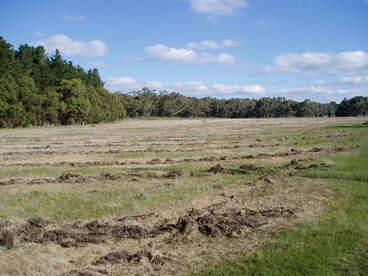 ImLal south in 2010. showing the lines sprayed with the herbicide glyphosate and then deep ripped before planting ImLal south in 2010. showing the lines sprayed with the herbicide glyphosate and then deep ripped before planting The holy grail - forestry that is biodiverse? The Ballarat group made a decision to plant a new style of forestry that aimed to be as biodiverse as the native bush found around Lal Lal. It would also include many of the elements of traditional forestry. They wanted to prove that forestry could be both economic and biodiverse, which meant that it should support the full diversity of local wildlife. These new plantations would employ the design principles recommended in ‘Recreating the Country’ a blueprint for the design of sustainable landscapes by Stephen Murphy, the author of this blog. ... and they called it ImLal Their plan was to plant two 4ha sites (Imlal south & Imlal north) connected by a wide biolink. Their intention was to recreate diverse layered indigenous 'dry-forest' similar to the remnant vegetation found locally. Commercial forestry tree species were also to be incorporated. The primary objective of the project was to restore both sites with income producing and biodiverse plantings.
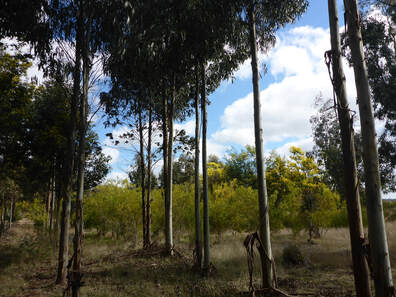 Form pruned Shining Gums, with a shrub layer of wattles behind. The taller understorey is also visible Form pruned Shining Gums, with a shrub layer of wattles behind. The taller understorey is also visible Ten years on Driving along the road to the Lal Lal falls and gazing to the left, ImLal south emerges as a surprising contrast to the surrounding landscape of tussocky swamps. There are groups of tall trees and there are clumps of bushy shrubs. Remarkably they look as if they have always been there. A visitor to the site will see very little difference between the Lal Lal State Forest and this new biorich plantation. A difference they would see is the 'form pruned' groups of tall trees that appear as long straight branchless poles. These will produce saw logs for sale in another 5 - 10 years. Standing near a group of 40 Shining Gums, Eucalyptus nitens, you can look through their smooth trunks to a bushy clump of 20 Hop Wattle, Acacia stricta, an indigenous small shrub of the Lal Lal area. Beyond the Hop Wattle, groups of indigenous Silver Banksia, Banksia marginata and Silver Wattle, A. dealbata create a taller understorey layer. If you stand perfectly still, you will see small birds moving from branch to branch, from tree to tree and from layer to layer. They’re safe and well fed in this sheltered vegetation mosaic that is the maturing biorich environment 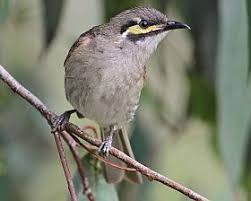 Yellow-faced Honeyeater, Lichenostomus chrysops. Photo Birdlife Australia Yellow-faced Honeyeater, Lichenostomus chrysops. Photo Birdlife Australia The bird life is truly remarkable. Regular bird surveys have been done since October 2011, a year after the first planting. Seasonal surveys are led by ornithologist Dr Grant Palmer from Federation University, Ballarat. Ornithologist, Tanya Loos led earlier surveys There was an initial siting in 2011 of one small flock of Yellow-faced Honeyeaters, Lichenostomus chrysops, eating insects from the leaves of one year old Blue Gums, Eucalyptus globulus. In 2019, over 30 surveys later, more than 80 species have been recorded at the site. Grant Palmer recorded 30 species in his diary on a blustery day in May 2016 and wrote; ‘We had the pleasure of observing many Yellow-faced Honeyeaters and New Holland Honeyeaters, a White-eared Honeyeater, a few Brown-headed Honeyeaters and White-naped Honeyeaters and Silvereyes all working through flowering Swamp Gum in the planted section, with Brown Thornbills and Superb Fairywrens working the lowest levels, a Spotted Pardalote pipping in the foliage, and a Golden Whistler was also lurking in the inner foliage. A Grey Shrike-thrush and Grey Fantail were also clearly associating with this group. Watching this group of birds over a number of minutes provided a real highlight for the day’ In November 2020 Grant Palmer recorded an amazing 46 bird species in his diary. He went on to describe the maturing vegetation and the diversity of birds observed; 'The growth in the planted vegetation has been fantastic to observe over the past few years and the structure of the vegetation is changing all the time with some patches becoming more dense as shrubby species grow and tree species regenerate, while other areas become more open as the canopy layer becomes more established. Importantly, resources like flowers and nectar are more available, attracting a diversity of honeyeaters. We were fortunate to observe Brown-headed, White-eared, White-naped, New Holland and Yellow-faced Honeyeaters foraging for nectar, as well as Red Wattlebirds and Silvereyes. Musk Lorikeets which also feed on nectar were present. The small resident birds were in good number too, and many of these were recorded in the planted areas, including Brown, Buff-rumped and Striated Thornbills, Superb Fairy-wren, White-browed Scrubwren, Spotted and Striated Pardalotes and Grey Fantail. Several Grey Shrike-thrush were calling, pleasing all with their full repertoire of sounds. Australian Magpie, Grey Currawong, Little Raven and Crimson Rosella were common'. 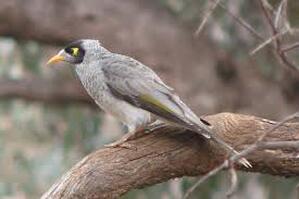 The flock of Noisy Miner, Manorina melanocephala have moved on The flock of Noisy Miner, Manorina melanocephala have moved on Encouragingly a resident flock of Noisy Miners Manorina melanocephala, an Australian native species that aggressively excludes all other small birds, has not been observed since 2013. Planting clumps of shrubs and understorey that now provide shelter and protection for small birds like the Striated Pardalote, Pardalotus striatus is likely to be responsible for the absence of the Noisy Miner. Pardalotes are now regularly seen. Grant Palmer simply and concisely explains why dominating flocks of Noisy Miner are a problem in bushland - click here then scroll down to read more about Noisy Miners 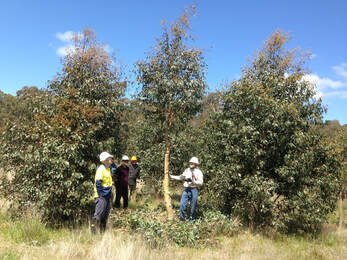 Four year old group-planted Swamp Gum, Eucalyptus ovata, at ImLal south Four year old group-planted Swamp Gum, Eucalyptus ovata, at ImLal south The design features that were used at ImLal to enhance biodiversity, sustainability and productivity are summarised here; (1) A diverse mix of indigenous plants from 16 families; 21 genera; and 33 species. The species list was compiled from;
(2) The inclusion of indigenous eucalypts (x5) and acacias (x7). These genera provide important food, habitat and resources for wildlife. (3) The creation of five vegetation layers which improves the feeding efficiency for wildlife and makes them less vulnerable to predators. The ground layer is developing as trees die or are thinned. These logs are left on the ground to provide habitat. (4) Clustering plants into same species groups of 5, 10, 20 & 50. The smaller species are planted as larger groups. (E.g. Kangaroo Grass, Themeda triandra, was planted in groups of 50; Tall Eucalypts species were planted in groups of 5). This ensures adequate pollination for fertile seed production and good foraging for wildlife. Planting this way automatically builds in structural vegetation layers. 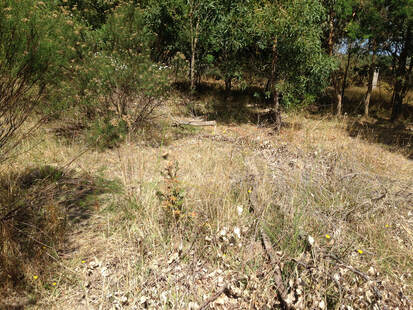 Naturally regenerating Swamp Gums amongst a clump of flowering Dogwood, Cassinia aculeata. Naturally regenerating Swamp Gums amongst a clump of flowering Dogwood, Cassinia aculeata. (5) Encouraging natural regeneration from the remnant roadside vegetation to within 40m of the adjoining boundaries. This is an exciting aspect of revegetation which encourages nature’s latent potential to gradually restore the open areas (6) The 150m average site width ensured excellent opportunities for regeneration of each species and minimises the edge effect making it attractive to more species of birds, mammals, insects, reptiles and amphibians (7) Developing vegetation linkages between the north and south sites by planting a biolink. Also linking to the roadside reserves and ultimately the remnant vegetation around the Lal Lal reservoir (8) Incorporating 12 forestry timber species in easily accessible large clumps to provide resources and a future income stream. These trees are form pruned to add value to the timber. Locally endangered Silver Banksia, Banksia marginata and Bushy Needlewood, Hakea decurrens have been planted as a seed orchard. There are many other possibilities to harvest seeds for food, for sale or for later revegetation projects. For example, the clumps of local Swamp Wattle, Acacia retinodes can provide seed for the food and beverage market. Click here to read more about wattle seed's prospects for becoming the next macadamia 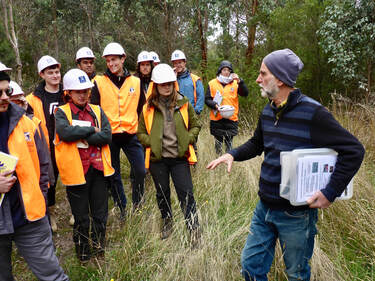 Melbourne University Forest System students visit in March this year. Photo Gib Wettenhall Melbourne University Forest System students visit in March this year. Photo Gib Wettenhall Experiencing is believing ImLal now attracts annual visits of forestry and environment students from Melbourne University, Federation University and Geelong TAFE. The students conduct surveys and experience the pleasing ambiance of this new style of revegetation. They can observe that it has many of the features of the natural bush with the addition of productive plants that will return a significant income in the future. They can appreciate that forestry and biodiversity can be happily married, while recovering much needed high quality habitat and species diversity that has been lost to wildlife through many decades of clearing.
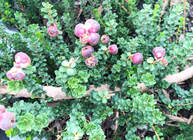 Click here to read more about how to design a biorich plantation which incorporates income generating plants into a diverse & sustainable biodiversity planting Photo - Delicious Muntrie fruit, Kunzea pomifera, as a ground layer species in a biorich plantation. It produces edible bushtucker for the culinary market and important on-ground habitat for insects, reptiles, amphibians and small mammals. A clear win-win 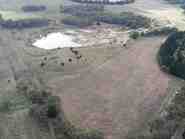 Click here to visit the biorich revegetation website to learn more about the design of the biorich sites at ImLal and the inspiring results. Photo. An aerial view of ImLal before it was planted showing the south and north sites separated by a large wetland which was once a kaolin quarry 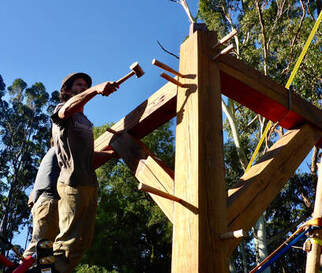 The construction of a hand crafted 'green' wood slab hut using wooden pegs to sucure the joins. Photo Gib Wettenhall The construction of a hand crafted 'green' wood slab hut using wooden pegs to sucure the joins. Photo Gib Wettenhall Meet the 21st century drop slab hut planned for ImLal (by Gib Wettenhall) Ballarat Region Treegrowers has now embarked on a small-is-beautiful project with wood craftsman Lachie Park at ImLal. The tiny hut will be a thing of beauty and spruik the quality and aesthetics of common local native timber as a materially renewable resource. The hut will demonstrate the resources that a biorich plantation can produce from timber to seeds, flowers and foliage. Once the hut is in place, it will service and add value to many more educational field trips for visitors to the demonstration site. To read more about this project click here
4 Comments
Suzette
17/4/2020 01:03:30 pm
Great to hear of this work being done with such passion in our backyard. Congratulations to all involved and hope to see this work replicated in the western district.
Reply
Steve
18/4/2020 05:25:32 pm
Hi Suzette,
Reply
Alison
4/5/2022 04:15:59 pm
Hi Steve,
Reply
Steve
31/5/2022 02:06:37 pm
Hi Alison,
Reply
Leave a Reply. |
Click on the image below to discover 'Recreating the Country' the book.
Stephen Murphy is an author, an ecologist and a nurseryman. He has been a designer of natural landscapes for over 30 years. He loves the bush, supports Landcare and is a volunteer helping to conserve local reserves.
He continues to write about ecology, natural history and sustainable biorich landscape design. 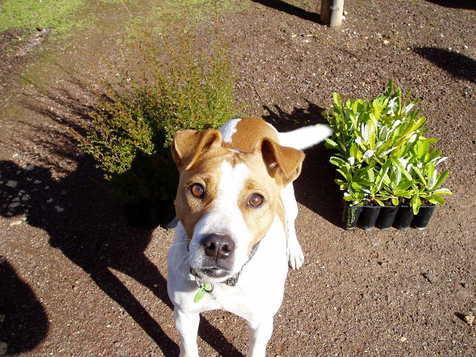
|
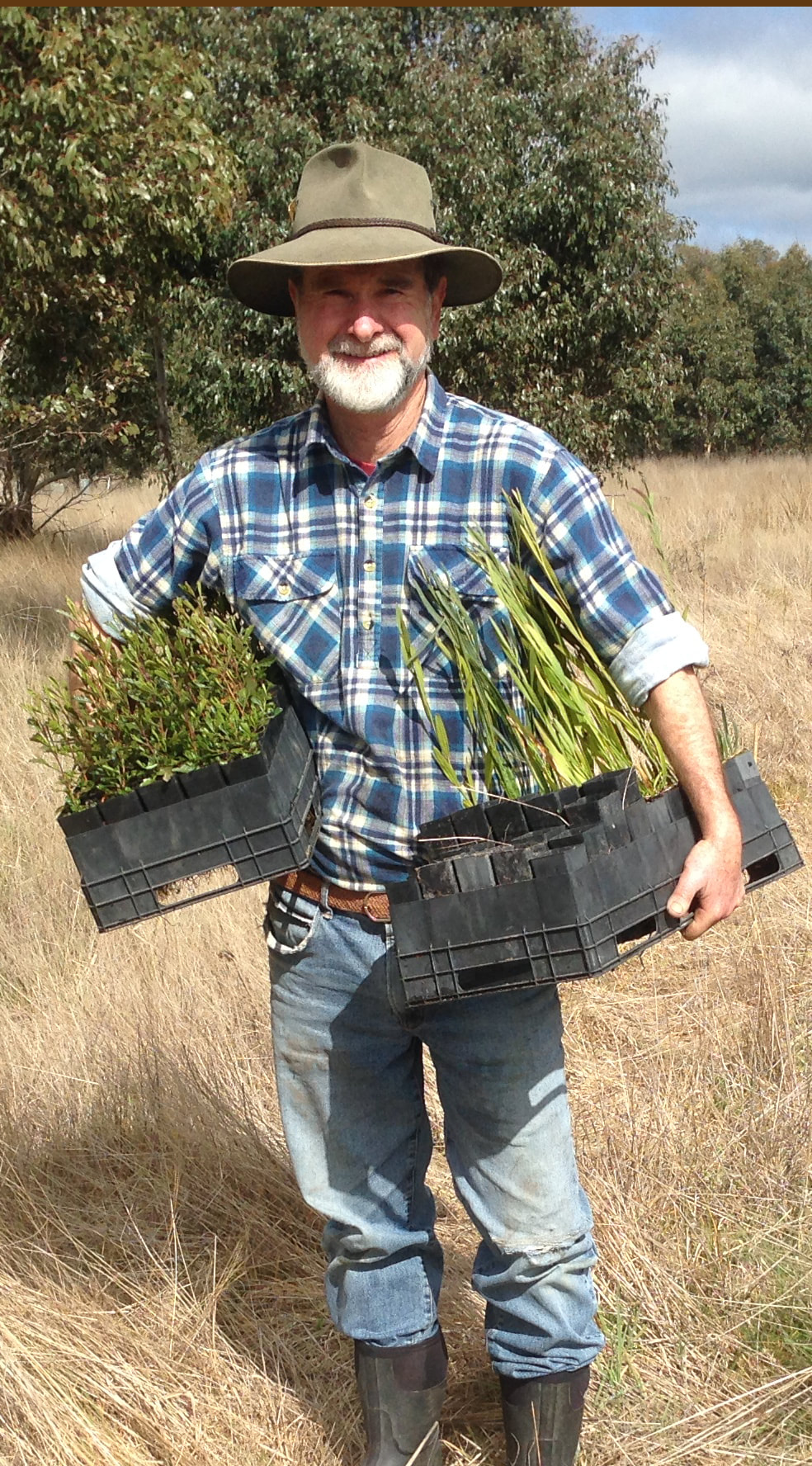

 RSS Feed
RSS Feed
